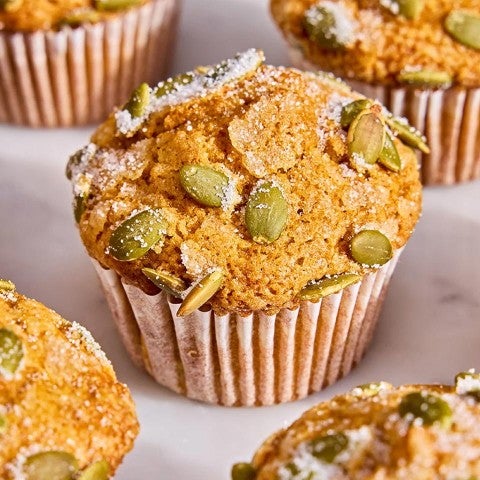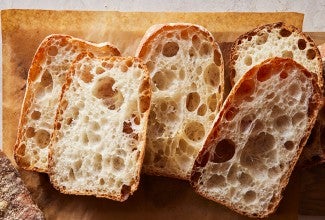-
To make the dough: Weigh your flour; or measure it by gently spooning it into a cup, then sweeping off any excess.
-
In a medium bowl, mix the dough ingredients until thoroughly combined and homogenous. Note: The dough starts off very slack and wet. That’s OK; it will transform itself through time and folds.
-
Oil a two-quart rectangular baking dish (10” x 7”) with 1 tablespoon of olive oil. If you don’t have a 2-quart dish, an 8” or 9” square pan will work. Don’t worry about any pan you use being oven-safe; you won’t be baking the bread in it.
-
Pour the dough into the dish. Check the dough’s temperature by inserting a digital thermometer into the center. If it's less than 72°F, move the dish to a warmer spot, e.g., your oven with the light turned on.
-
Cover the pan and allow the dough to rest for 20 minutes.
-
To do a bowl fold: Use your wet hands to grab a section of dough from one side, lift it up, then press it down into the middle. Repeat this eight to 12 times. (See step 6 on the original Pan de Cristal recipe to see a video demonstrating a bowl fold.)
-
Cover the dish and allow the dough to rest for 20 minutes.
-
To do a coil fold: With wet hands, reach under the dough and stretch the middle upward until the dough releases from the dish. Roll it forward off your hands, allowing it to fold over (or “coil”) on itself. Rotate the dish 90°(a quarter turn) and repeat. Continue performing this folding action until the dough feels like it won’t stretch and elongate easily, usually four to five times. (See step 8 of the original Pan de Cristal recipe for a demonstration of a coil fold.)
-
Cover the dish and allow the dough to rest for 20 minutes.
-
Repeat the coil fold. Cover the dish and allow the dough to rest for 20 minutes. Note: The dough should be gaining strength and becoming easier to handle with each fold.
-
Repeat the coil fold one last time. Cover the dish and allow the dough to rest for 20 minutes. The dough should have gained quite a bit of strength while also feeling light and airy.
-
To add the chocolate: As gently as possible, turn the dough out onto a work surface spritzed with water. Gently coax the dough into a rectangle about 14” x 10” with the long side facing you.
-
Sprinkle the dough evenly with the chocolate. Fold one of the short sides into the center, then fold the opposite third over the first, like you were folding a business letter. (This is called a letter fold.)
-
Fold the dough a second time by bringing the top third of the dough down towards the center, then bringing the bottom third up to cover the top portion (another letter fold). Return the dough to the oiled dish to rise for about 80 minutes, until puffy.
-
To divide the dough: Gently turn the dough out onto a heavily floured surface. Sprinkle a generous amount of flour on top of the dough and roll the cut sides of the dough on the floured surface so no sticky spots are exposed. Tuck any visible pieces of chocolate into the dough to prevent them from burning.
-
Working as gently as possible, use a bench knife or other sharp knife to divide it into eight pieces. Place four pieces on a sheet of parchment, leaving space between them. Repeat with the remaining four pieces of dough, placing them on another sheet of parchment.
-
Let the rolls rest at room temperature for 2 hours, uncovered. While they're resting, preheat the oven to 475°F with a baking stone or steel on a lower rack. Allow the oven to preheat for 1 hour to ensure it’s thoroughly heated.
-
To bake the rolls: Carefully slide the four rolls (still resting on the parchment) into the oven onto the preheated stone or steel. (A baker’s peel or a rimless cookie sheet is a helpful tool here.) If space is tight and the full sheet of parchment won’t fit on the stone or steel, cut the parchment between the four rolls and arrange them as best you can. Allow the other rolls to continue to rest.
-
Bake the rolls for 10 to 12 minutes, then transfer them to a rack in the upper third of the oven for an additional 8 minutes. Moving them allows the baking stone or steel to become hot again in preparation for the next four rolls. After a total of 18 to 20 minutes of baking, remove the rolls from the oven and allow them to cool on a rack.
-
Repeat the process with the remaining rolls. For maximum crispiness, cut and enjoy while still slightly warm. Rewarm briefly to restore the crispiness, if desired.
-
Storage information: Wrap the rolls loosely and store them at room temperature for up to several days; freeze for longer storage.




















